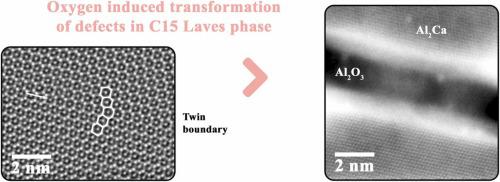Journal of Alloys and Compounds ( IF 6.2 ) Pub Date : 2022-11-30 , DOI: 10.1016/j.jallcom.2022.168296 Nicolas J. Peter , Daniela Zander , Xumeng Cao , Chunhua Tian , Siyuan Zhang , Kui Du , Christina Scheu , Gerhard Dehm

|
With an ongoing discussion on the oxygen diffusion along crystal defects remaining, it is difficult to study this phenomenon in Al containing intermetallic materials due to its rapid and passivating oxide formation. We report here the observation of enhanced oxygen diffusion along crystal defects, i.e. dislocations and twin boundaries, in the C15 Al2Ca Laves phase and how the presence of oxygen induces structural changes at these defects. Three main phases were identified and characterized structurally by aberration-corrected, atomic resolution scanning transmission electron microscopy, analytically by energy dispersive X-ray spectroscopy and electron energy loss spectroscopy. Unlike the C15 bulk phase, the twin boundary and dislocation transformed into a few nanometer wide amorphous phase, which depletes in Al and Ca but is highly enriched in oxygen. The dislocation even shows coexistence of the amorphous phase with a simple Al-rich A1 fcc phase. This A1 phase only depletes in Ca, not in Al (Al remains at bulk concentration), and is also enriched in oxygen. The Al-rich A1 phase is coherent with the C15 matrix. Electron energy loss spectroscopy revealed the amorphous phase to be Al2O3. We thereby show as one of the first studies that oxygen diffusion along crystal defects, especially also at the twin boundary can induce the formation of an amorphous oxide along themselves. The identification of oxygen-induced transformation at strained defects has to be considered when the material is exposed to air during plastic deformation at elevated temperatures.
中文翻译:

Al2Ca 中氧的首选腐蚀途径——双晶界和位错
随着关于氧气沿晶体缺陷扩散的持续讨论,由于其快速和钝化氧化物的形成,很难研究含铝金属间材料中的这种现象。我们在此报告了在 C15 Al 2中沿晶体缺陷(即位错和孪晶边界)增强氧扩散的观察结果Ca Laves 相以及氧的存在如何引起这些缺陷的结构变化。通过像差校正、原子分辨率扫描透射电子显微镜,通过能量色散 X 射线光谱和电子能量损失光谱进行分析,在结构上识别和表征了三个主要相。与 C15 体相不同,孪晶界和位错转变为几纳米宽的非晶相,其耗尽 Al 和 Ca,但富含氧。位错甚至显示非晶相与简单的富铝 A1 fcc 相共存。该 A1 相仅耗尽 Ca,而不耗尽 Al(Al 保持体积浓度),并且还富含氧。富含铝的 A1 相与 C15 基质相一致。电子能量损失谱显示非晶相为铝2 O 3。因此,作为最早的研究之一,我们表明氧沿着晶体缺陷扩散,尤其是在双边界处,可以诱导非晶氧化物沿着它们自身的形成。当材料在高温下塑性变形过程中暴露在空气中时,必须考虑识别应变缺陷处的氧诱导转变。



























 京公网安备 11010802027423号
京公网安备 11010802027423号